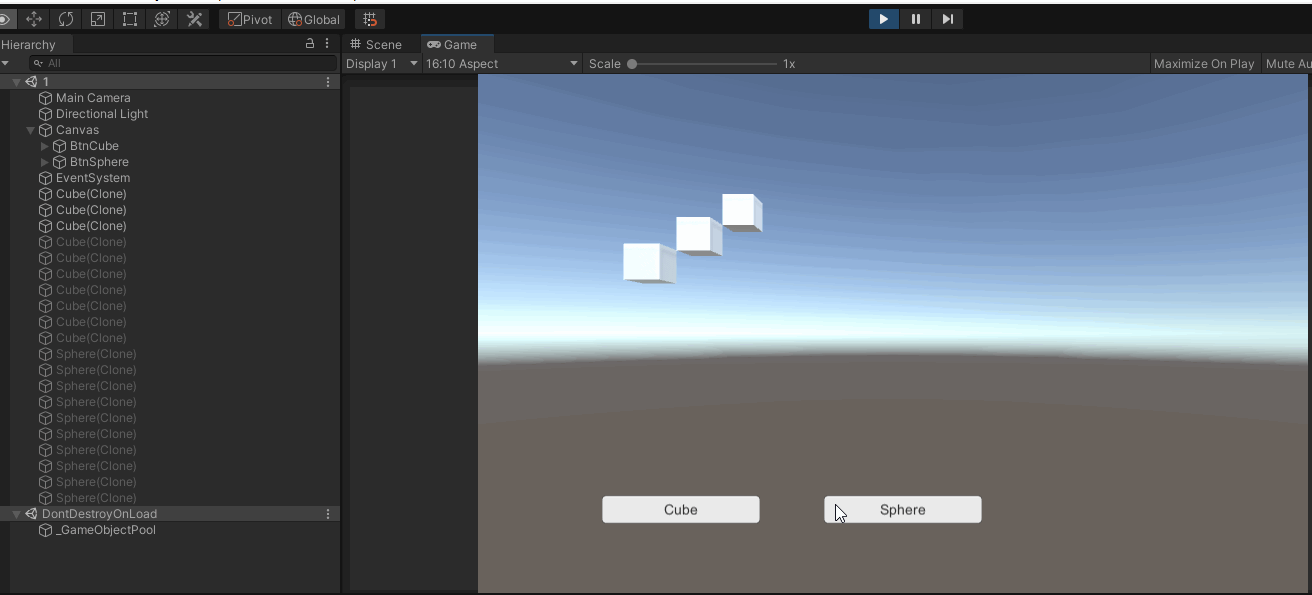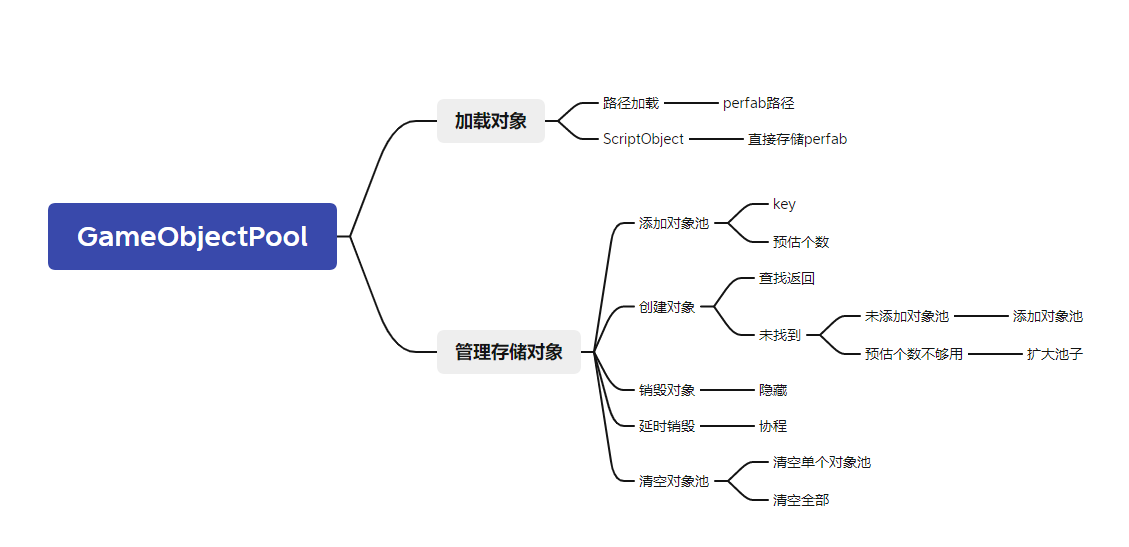
在游戏中会出现大量重复的物体需要频繁的创建和销毁;比如子弹,敌人,成就列表的格子等;
频繁的创建删除物体会造成很大的开销,像这种大量创建重复且非持续性保持作用的对象我们会使用对象池将其管理起来,用空间换效率;
对象池的要对外提供创建销毁对象的接口,已经添加对象池的接口;
对内要提供创建对象,根据路径查找预制的接口;
整体逻辑如下:

添加资源路径,分为Resources文件夹下和SteamingAssets文件下资源;
Resources加载时路径不需要后缀,SteamingAssets需要后缀,根据path路径开头的判断加载方式,同时对路径做处理;
SteamingAssets需要根据平台添加路径头Application.streamingAssetsPath;
Resources需要去掉格式后缀,如.perfab;
这里我测试只使用Resources路径,正式项目自行处理;
存放预创建好的对象:
private Dictionary<string,List<GameObject>> pool;存放预制体路径:
private Dictionary<string, string> objPath; public void InitPath() { //测试用,正常肯定要做字符串处理的,需要加后缀 objPath.Add("cube","Cube"); objPath.Add("sphere","Sphere"); } public void Add(string key, int num) { if (pool.ContainsKey(key)) { for (int i = 0; i < num; ++i) { //AssetBundle ab = AssetBundle.LoadFromFile($"{path}/{objPath[key]}"); //GameObject go = Instantiate(ab.LoadAsset<GameObject>(key)); //由于我的测试资源就放在Resources下,正式项目需要根据路径做个判断; GameObject go = Instantiate(Resources.Load<GameObject>(objPath[key])); go.SetActive(false); pool[key].Add(go); } } else { List<GameObject> goList = new List<GameObject>(); pool.Add(key, goList); for (int i = 0; i < num; ++i) { //AssetBundle ab = AssetBundle.LoadFromFile(objPath[key]); //GameObject go = Instantiate(ab.LoadAsset<GameObject>(key)); GameObject go = Instantiate(Resources.Load<GameObject>(objPath[key])); go.SetActive(false); pool[key].Add(go); } } } 三.管理对象池对象池管理需要对外提供创建对象,销毁对象,延迟销毁和清空池的方法;
创建对象时,需要提供key,坐标,旋转;
现查找是否有对象池,没有则添加;
这里提供了四元素和欧拉角的重载方法;
1.创建对象 public GameObject FindUsable(string key { if(pool.ContainsKey(key)) { foreach (GameObject item in poo { if (!item.activeSelf) return item; } Debug.Log($"{key}的对象池数量不够"); } else { Debug.Log($"{key}未添加对象池"); } return null; } /// <summary>创建一个游戏物体到场景 </summary> public GameObject CreateObject(string k { GameObject tempGo = FindUsable(key) if (tempGo == null) { Debug.Log($"{key}的对象池数量不够"); Add(key, 10); tempGo = FindUsable(key); } tempGo.transform.position = positio tempGo.transform.rotation = quatern tempGo.SetActive(true); return tempGo; } public GameObject CreateObject(string k { GameObject tempGo = FindUsable(key) if (tempGo == null) { Debug.Log($"{key}的对象池数量不够"); Add(key, 10); tempGo = FindUsable(key); } tempGo.transform.position = positio tempGo.transform.rotation = Quatern tempGo.SetActive(true); return tempGo; } 2.销毁对象延时销毁可使用回调(invoke)或协程;
public void Destory(GameObject destoryGo) { destoryGo.SetActive(false); } /// <summary>将对象归入池中<summary> public void Destory(GameObject tempGo, float delay) { StartCoroutine(DelayDestory(tempGo,delay)); } /// <summary>延迟销毁</summary> private IEnumerator DelayDestory(GameObject destoryGO, float delay) { yield return new WaitForSeconds(delay); Destory(destoryGO); } 3.清空池 /// <summary>清空某类游戏对象</summary> public void Clear(string key) { pool.Remove(key); } /// <summary>清空池中所有游戏对象</summary> public void ClearAll() { pool.Clear(); } 四、测试代码两个按钮分别创建方块和球,每次创建更改一次位置;鼠标射线点击延迟1s销毁;
public class Test : MonoBehaviour { public Button btnCube; public Button btnSphere; void Start() { GameObjectPool.I.InitPath(); GameObjectPool.I.Add("cube",10); GameObjectPool.I.Add("sphere",10); btnCube.onClick.AddListener(OnBtnCube); btnSphere.onClick.AddListener(OnBtnSphere); } private Vector3 deltaPos = new Vector3(1, 1, 1); private Vector3 pos =new Vector3(-10,0,0); private void OnBtnCube() { GameObject go = GameObjectPool.I.CreateObject("cube", pos, Vector3.zero); go.transform.SetParent(null); SceneManager.MoveGameObjectToScene(go, SceneManager.GetSceneByName("1")); go.transform.position += deltaPos; pos = go.transform.position; } private Vector3 pos1 =new Vector3(0,0,0); private void OnBtnSphere() { GameObject go = GameObjectPool.I.CreateObject("sphere", pos1, Vector3.zero); go.transform.SetParent(null); SceneManager.MoveGameObjectToScene(go, SceneManager.GetSceneByName("1")); go.transform.position += deltaPos; pos1 = go.transform.position; } private void Update() { if(Input.GetMouseButtonDown(0)){ Ray ray = Camera.main.ScreenPointToRay(Input.mousePosition); RaycastHit hitInfo; if(Physics.Raycast(ray,out hitInfo)){ Debug.DrawLine(ray.origin,hitInfo.point); GameObject gameObj = hitInfo.collider.gameObject; Debug.Log("click object name is " + gameObj.name); GameObjectPool.I.Destory(gameObj,1); } } } }
